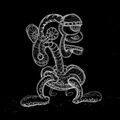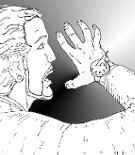Template:Selected anniversaries/October 20: Difference between revisions
No edit summary |
No edit summary |
||
| Line 18: | Line 18: | ||
||1906: Crockett Johnson born ... pen name of the American cartoonist and children's book illustrator David Johnson Leisk. He is best known for the comic strip Barnaby (1942–1952) and the Harold series of books beginning with Harold and the Purple Crayon. From 1965 until his death Johnson created over a hundred paintings relating to mathematics and mathematical physics. Pic. | ||1906: Crockett Johnson born ... pen name of the American cartoonist and children's book illustrator David Johnson Leisk. He is best known for the comic strip Barnaby (1942–1952) and the Harold series of books beginning with Harold and the Purple Crayon. From 1965 until his death Johnson created over a hundred paintings relating to mathematics and mathematical physics. Pic. | ||
||1912: American linguist and codebreaker Meredith Knox Gardner born. Gardner worked in counter-intelligence, decoding Soviet intelligence traffic regarding espionage in the United States, in what came to be known as the Venona project. Pic. | |||
||1914: R. H. Bing born ... mathematician who worked mainly in the areas of geometric topology and continuum theory. Pic: https://www.maa.org/about-maa/governance/maa-presidents/rh-bing-1963-1964-maa-president | ||1914: R. H. Bing born ... mathematician who worked mainly in the areas of geometric topology and continuum theory. Pic: https://www.maa.org/about-maa/governance/maa-presidents/rh-bing-1963-1964-maa-president | ||
| Line 23: | Line 25: | ||
||1919: Matthew Sands born ... physicist and educator best known as a co-author of the ''Feynman Lectures on Physics''. Pic. | ||1919: Matthew Sands born ... physicist and educator best known as a co-author of the ''Feynman Lectures on Physics''. Pic. | ||
||1919: Tracy Hall born ... chemist and academic; synthetic diamond. Pic search | ||1919: Tracy Hall born ... chemist and academic; synthetic diamond. Pic search cool. | ||
||1925: Theodore Hall born ... American physicist and an atomic spy for the Soviet Union, who, during his work on US efforts to develop the first and second atomic bombs during World War II (the Manhattan Project), gave a detailed description of the "Fat Man" plutonium bomb, and of several processes for purifying plutonium, to Soviet intelligence. Pic. | ||1925: Theodore Hall born ... American physicist and an atomic spy for the Soviet Union, who, during his work on US efforts to develop the first and second atomic bombs during World War II (the Manhattan Project), gave a detailed description of the "Fat Man" plutonium bomb, and of several processes for purifying plutonium, to Soviet intelligence. Pic. | ||
| Line 48: | Line 50: | ||
||1973: The Sydney Opera House is opened by Elizabeth II after 14 years of construction. | ||1973: The Sydney Opera House is opened by Elizabeth II after 14 years of construction. | ||
||1974: Harold Stanley Ruse dies ... mathematician, noteworthy for the development of the concept of locally harmonic spaces. Pic search | ||1974: Harold Stanley Ruse dies ... mathematician, noteworthy for the development of the concept of locally harmonic spaces. Pic search. | ||
|File:Skip Digits.jpg|link=Skip Digits|1981: Musician and alleged math criminal [[Skip Digits]] begins North American tour. | |File:Skip Digits.jpg|link=Skip Digits|1981: Musician and alleged math criminal [[Skip Digits]] begins North American tour. | ||
| Line 60: | Line 62: | ||
File:Andrey Kolmogorov.jpg|link=Andrey Kolmogorov (nonfiction)|1987: Mathematician and academic [[Andrey Kolmogorov (nonfiction)|Andrey Kolmogorov]] dies. Kolmogorov made pioneering contributions to the mathematics of probability theory, topology, intuitionistic logic, turbulence, classical mechanics, algorithmic information theory, and computational complexity. | File:Andrey Kolmogorov.jpg|link=Andrey Kolmogorov (nonfiction)|1987: Mathematician and academic [[Andrey Kolmogorov (nonfiction)|Andrey Kolmogorov]] dies. Kolmogorov made pioneering contributions to the mathematics of probability theory, topology, intuitionistic logic, turbulence, classical mechanics, algorithmic information theory, and computational complexity. | ||
||1989: Mathematician Dmitry Konstantinovich Faddeev dies. Faddeev and his wife Vera jointly wrote the influential book ''Numerical Methods in Linear Algebra''; they also developed an algorithm to find the resolvent matrix of a given matrix A. Pic search | ||1989: Mathematician Dmitry Konstantinovich Faddeev dies. Faddeev and his wife Vera jointly wrote the influential book ''Numerical Methods in Linear Algebra''; they also developed an algorithm to find the resolvent matrix of a given matrix A. Pic search. | ||
||2012: E. Donnall Thomas dies ... physician and academic, Nobel Prize laureate. | ||2012: E. Donnall Thomas dies ... physician and academic, Nobel Prize laureate. | ||
Revision as of 06:39, 1 May 2020
1631: Astronomer and mathematician Michael Maestlin dies. He was a mentor to Johannes Kepler, and played a sizable part in his adoption of the Copernican system.
1947: Singer-physicist J. R. Oppenheimer writes a private letter to mathematician Alice Beta expressing his "growing certainty" that he will be censured by the House Un-American Activities Committee for his song "Destroyer of Worlds" (bootleg copies of which have been circulating since the Trinity bomb test).
1947: The House Un-American Activities Committee begins its investigation into Communist infiltration of the cinema of the United States, resulting in a blacklist that prevents some from working in the industry for years.
1947: Mathematician and Gnomon algorithm theorist Alice Beta publicly denounces the House Un-American Activities Committee as "an intolerable blight on free association, free speech, free thought, and freedom itself."
1960: Mathematician, academic, and APTO field engineer Wacław Sierpiński visits the Nested Radical coffeehouse, where he gives an impromptu lecture on how the Zermelo–Fraenkel set theory together with the Generalized continuum hypothesis implies the axiom of choice.
1987: Mathematician and academic Andrey Kolmogorov dies. Kolmogorov made pioneering contributions to the mathematics of probability theory, topology, intuitionistic logic, turbulence, classical mechanics, algorithmic information theory, and computational complexity.
2018: Signed first edition of Creature 4 stolen from the Louvre in daylight robbery by agents of the Forbidden Ratio gang.







